#also multiplane camera my love
Text
Thinking about how I wish there was more mainstream talk about older animation (1920s to the 1950s) as works of art
#rewatched little april shower and was enamoured with the animation the background the special effects#all when inking and coloring was done by hand#not that cg animation isnt art but i dont know theres something about detailed nature and shots of lightning#knowing everything im seeing was done by hand#2d animation#animation#also multiplane camera my love#i also caught some of a popeye short awhile back and the animation was loose and fluid#rambling tags#disney#fleischer studios#looney tunes#those are the studios that leap to mind#theres lotte reiniger but thats a different (though also good art) animation#or maybe there is and im not aware of it
15 notes
·
View notes
Text
Testing Materials Week 2-3
vimeo
This is a compilation of tests I did on the multiplane.
At first I started with charcoal, then some string animation, and clay and oil. As well as a pyrography test on a slab of wood. I am writing to describe my thoughts and processes of each and to hopefully decide on one medium.
I first started with the pyrography tool which essentially was a soldering rod. It was great fun, very hot, and Smokey so I will definitely include a mask and a heatproof glove if I choose this going forward. Its burn effect is exactly what I'm looking for, so I am eager to make this work for me. I will however need to source my own wood potentially going out and finding it rather than ordering this. I did a quick test of drawing charcoal next to the pyro test to see how they look next to each other. I feel as though I could combine them together, possibly closer to the design stage/production.

On the multiplane I did three different charcoal tests, on different coloured paper. I had quickly drawn a rough plan for the first sapling animation. Since it was at the beginning of using the multiplane we had the lighting set up however the bulb went off one which is why it wasn't set so well. And wasn't until later this was replaced. I wasn't to worried about this since its only to see if I like the materials and If it's doable. We used dragon frame software to capture this, and made sure with a focus check it was picking up the details with the camera. Once this was sorted we added the keys for either two or single frame buttons. I was told that the lens would also have to be changed for the multiplane to a 50mm however I was just glad to even start. Once all setup and wires were in order My next issue was that I would have to animate upside down. I did this for the first two. As you can see they are off centre although I did try to mark out the corners this was still hard for me. Versus the last version which you can see I flipped this after in after effects. Certainly drawing the face is clearer, but it is to high up and not centred. I have to also be sure not to leave things on frame, I momentarily left a rubber on the first one within a shoot. Luckily I have managed to edit this out. I am really drawn to the express nature of charcoals in general and would hope to find a way I can Incorporate this.
When it comes to clay I did not have a lot to use. So I had to try to make the slab tile I rolled out thick enough for when I drew into this as you can see it wasn't to visible versus when I applied clay above. If I had ore clay I might have been able to do a larger slab and more able to do bigger, artwork for it's animations. At this time we managed to get a second light working so I had to rework the exposure and camera settings again. I think if I had spent a little more time working with this I might have got a better looking result. However, I personally got the feeling I would not be using clay since it did not give the same expressive freedom I had in charcoal. It was still a worthy try as I personally do love working in clay. It would just not meant to be.
When It comes to the oil which I barely touched and was only 0.5 of a second, it was an instant no. And I could not think of a way to get it to animate clearly. So what I did to save clean up was tape this clear film above the class. Now reflecting, since I used two planes instead of one the lower one was the back ground anyway. Instead of Making the top layer with too much white, I should have only done the black branch. My thinking was I need the white to add and take away. Upon this reflection I am learning from my mistakes and taking the time to reflect has certainly helped in this case.
Last but not least I just did some quick string-over-fabric animation. Initially, I was going to embryoid this. However, I could not see a way to do this unless I had something to stretch the fabric like a hoop or a frame I could secure and staple fabric to this. Unfortunately, I thought of this a little late as I do not have the funds for this. So instead I played with the string. and tried to see how much control I would have over this and how could I make it look like something. Well, I tried at first to see how tight I could hold the shape. Unfortunately, It could not do this very well. It could, however, look and move very fluidly like so the first one is meant to resemble water a bit, whereas the second one is meant to resemble a fish whose tail is reacting to the forces around this. Overall this is not bad and I may come back with a hoop or something to update and add later as a side project if I have time before Thursday so I can really get a feel.


0 notes
Text
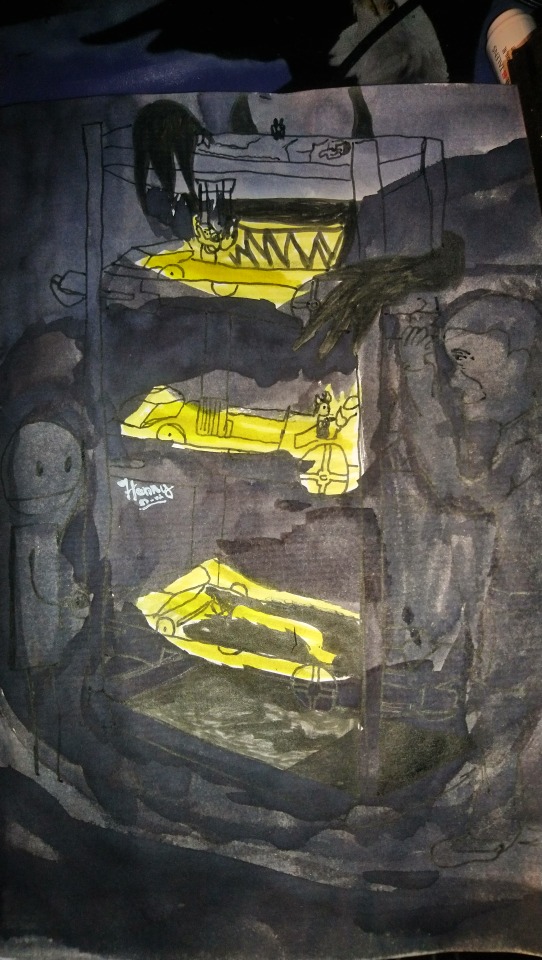
The Ink Demonth [by Halfusek]
Day 27 - Control
It's a little game between Henry and Joey Drew, and they are the toys of this devilshly handsome puppet, TheMeatly, who control the studio like a multiplane camera. And we play to his game, maybe our reactions and ideas, theory and else go in the way that he planned, because Meatly is playfull and love secrets, also he give all care and attention for making Bendy and the Ink Machine a beautiful marvellous game, with all his friends of Joey Drew studios and Kindly Beast. Thanks to them, I never feel so much love and stars in my eyes since Touhou Project games in 1998 and BioShock games in 2013. That's why I create the "Gamer Triforce" with those three games.
+Bonus! An alternate cute version of how TheMeatly play with his favorites toys. :]

And I'm late again but I really take too much time while I ink the fanarts. And I'm so perfectionnist. But probably the most important is it's done! I guess?
#the ink demonth#bendy and the ink machine#fanart#themeatly#joey drew#bendy#beast bendy#joey drew studios#multiplane camera#playful#puppet#gamedev#game developers#traditional drawing#traditional art#inkdrawing#sepia tone#sepia#light in the dark#dark
16 notes
·
View notes
Text
My Recent Media Diet, The "It's Not Life or Death, It's Just Tacos" Edition
I keep track of every media thing I "consume", so here are quick reviews of some things I've read, seen, heard, and experienced in the past two months. I never wrote a proper report on my trip to Mexico City, so I put some of the highlights in here. I'm in the middle of several things right now. On TV, I'm watching Our Planet, In Search of Greatness, Street Food, Chernobyl, The Clinton Affair, Reconstruction: America After the Civil War, and This Giant Beast That is the Global Economy. I don't normally watch 19 different things at one time, but life's felt a little scattered lately. For books, I'm listening to Guns, Germs, and Steel by Jared Diamond on audiobook and I'm making good progress on Robert Caro's Working (highly recommended).
The Silk Roads: A New History of the World by Peter Frankopan. Hard to summarize but there's certainly something interesting on almost every page. (A-)
youtube
Fleabag. Bitingly funny and poignant, a real gem. (A+)
Skyscraper. Die Hard + the Sherlock Holmes story A Scandal in Bohemia + #sponcon for Big Duct Tape. I love a good disaster movie. (B+)
Mexico City. Great food, vegetation everywhere, beautiful architecture, culturally fascinating, super walkable/bikeable/scooterable. I am definitely visiting here again as soon as I can. (A)
Puyol Taco Omakase. Delicious & fun & a great experience, but I'm not sure the food was obviously so much better than some of the best street food I had in Mexico City. I had this same experience in Bangkok years ago...street food is tough to beat when there's a thriving culture of markets, carts, and stalls. (B+)
The National Museum of Anthropology. One of my new favorite museums in the world. The only thing possibly more impressive than the collection is the architecture of the building. (A+)
Teotihuacán. I had high hopes for this archeological site and I was still blown away by it. (A+)
AirPods. This is my favorite gadget in years, the first real VR/AR device that feels seamless (and not like a Segway for your face). The freedom of wireless headphones feels similar to when I first used a laptop, wifi, and dockless bike share. (A+)
Homecoming. So many things to love about this, but one of my favorites is the shots of the audience watching Beyoncé and the rare moments when she watches them back: "I see you." And also the way they put a cohesive show together while showcasing individual talents and styles. (A-)
Homecoming: The Live Album. Come on, a marching band playing Beyoncé hits? That this works so well is a small miracle. (A-)
Avengers: Endgame. I liked but didn't love it. It was like the ST:TNG finale and the Six Feet Under finale mashed together and not done as well. It also seemed too predictable. (B)
Avengers: Age of Ultron. Now that the Thanos narrative arc is complete, this is an underrated installment. (B+)
Casa Luis Barragán. This was like being in someone's creative mind. The layering of the garden reminded me of Disney's use of the multiplane camera in the forest scene in Bambi. (B+)
Gelatin Sincronizada Gelitin (NSFW). I was skeptical of this art performance at first -- a bunch of half-naked people painting on a moving canvas using paintbrushes coming out of their butts -- but it ended up being a really cool thing to experience. (B+)
Game of Thrones. I'm not quite as critical of the final season as everyone else seems to be. Still, it seems like since the show left the cozy confines of George RR Martin's books, it has struggled at times. (B+)
Wandering Earth. Based on the short story by Liu Cixin (author of the Three Body Problem trilogy), this disaster movie is a little uneven at the start but finishes strong. (B)
Halt and Catch Fire Vol 2. The music was one of the many great things about this show. (A-)
Running from COPS. A podcast about how media and law enforcement in America intersect to great and terrible effect. (B+)
Eating bugs. I tasted crickets, grasshoppers, and grubs at the market: mostly just salty. I had beef tartare and guacamole with grasshoppers on it. They added a nice crunch to the guac. Wouldn't exactly go out of the way for them, but they weren't bad. (B)
Panaderia Rosetta. Did I have one of the best pain au chocolat I've ever had here? Yes. Yes, I did. Also extremely delicious: everything else I tried. (A-)
Against the Rules. A podcast from Michael Lewis about what's happening to the concept of fairness in America. The episode about Salvator Mundi, the supposed Leonardo masterpiece, is particularly interesting. (A-)
Tolkien: Maker of Middle-earth. I have a new appreciation of how much Tolkien did in creating his books: writing, map making, world building, art, constructing languages. (B+)
Frida Kahlo's Blue House. A striking house with a lush courtyard, but the highlight was seeing Kahlo's work area much the way she left it when she died. (B+)
Street Food Essentials by Club Tengo Hambre. Mexico City is a huge place with so much to do that I wanted to hit the ground running right away, so I booked this street food tour. Definitely a good idea. We sampled so many different kinds of tacos & gorditas & quesadillas that I lost count. Highlights: huitlacoche quesadillas, al pastor tacos, fresh Oaxaca cheese at the Mercado de San Juan, and the blue corn masa used to make tlacoyos at one of our last stops -- probably the best tortilla I've ever eaten. (A-)
The Matrix. This came out 20 years ago. I watched it with my 11-yo son the other day and he thought the special effects "held up pretty well". (A)
Electric scooters. I used the Lime dockless electric scooters for the first time when I was in Mexico City and I loved experience. Easier than a bike and a fun & fast way to get around the city. Cons: the combo of the speed & small wheels can be dangerous and cities generally don't have the infrastructure to accommodate them yet. (B+)
Paprika. Inventive and visually dazzling. Purportedly an influence on Christopher Nolan's Inception. (B+)
Oh and just because, here's a photo I took recently in my backyard that makes it seem like I live in Narnia or The Shire:
Past installments of my media diet are available here.
4 notes
·
View notes
Photo

Shiver Me Timbers! (1934 short)
As animated short films emerged from the silent film era, the major Hollywood studios acquired or partnered with animation studios to quickly produce shorts that could be shown before or in between movies. One of the most important names in American animation in the 1930s was Fleischer Studios – co-founded by brothers Max and Dave Fleischer – partnering with Paramount. The Fleischer shorts, unlike their competitors across town, usually concentrated on human characters – their filmography more commercial than artistic for art’s sake. Due to messy rights issues and modern-day corporations not seeing the value in the older movies they have acquired, much of the Fleischer filmography is unknown to audiences. That includes the films of Betty Boop, whom younger generations have a superficial knowledge about (the upstart company Olive Films has recently remastered some of the non-public domain Betty Boop shorts for home media), and the seventeen Superman shorts released from 1941-1943.
Surviving this mélange of media acquisitions, mergers, and dismissive attitudes to older media is Popeye the Sailor. Popeye, introduced in a comic strip in 1929 and first appearing in cinemas in 1933, has outlasted in the public imagination anything else that Fleischer Studios ever released. The visibility of the muscular, spinach-loving, pipe-smoking sailor has been kept intact because of the character’s rights belonging to Turner Entertainment (whose properties include Cartoon Network – which used to air Popeye regularly – and Turner Classic Movies, TCM) by way of Warner Bros. With Halloween nearing, the subject of this write-up is the twelfth of 108 Popeye shorts released by Fleischer Studios from 1933-1942 (Fleischer’s successor, Famous Studios, increased that total to 230 through 1957), Shiver Me Timbers! The film is credited to Dave Fleischer as a director, but research has shown his duties were closer to being a producer and creative supervisor. Most of the directorial work probably fell to credited animators Willard Bowsky and William Sturm.
Released in midsummer 1934, this is an early Popeye piece: in black-and-white, well within the era of rubber hose animation, the sound mix imperfect. After presumably being out in the ocean, Popeye (voiced by William Costello), Olive Oyl (Mae Questel; if you are unfamiliar with the Popeye series, Olive is Popeye’s longtime love interest of varying ambiguous relationship statuses... Questel is also an underrated voice actress), and Wimpy (Lou Fleischer) stumble upon a ruined, beached ship – its sails tattered, its wooden planks falling apart. Popeye immediately recognizes this to be a ghost ship and decides to investigate – against Olive’s better judgements. This film would not be interesting if they decided against climbing onboard, so of course they climb up the ladder that magically unfurls itself onto the ship’s deck! The ship moves itself off the beach, out to sea, and the spooks haunting the ship start toying with the too-curious mortals.
What makes the Fleischer animated shorts so difficult to judge compared to their peers from Walt Disney Animation Studios (partnered with Columbia, United Artists, and RKO at separate times across the 1930s; Disney did not become a major studio until the 1990s) and Warner Bros. (their animation arm an in-house body of the studio) is that they are largely formulaic. Popeye might be the most formulaic of all the Fleischer series, especially the later years under the Famous Studios moniker. The narrative usually follows this order: Popeye finds himself chasing or with the love of his life in Olive Oyl; arch-nemesis Bluto enters the scene and proceeds to abduct or, with dishonorable intentions, flirt with Olive; Olive winds up in trouble; Bluto beats the living daylights out of Popeye in ways that would otherwise kill any normal person; near unconsciousness or death, Popeye eats his spinach and proceeds to give Bluto (and his minions, if applicable) a walloping outdoing anything Bluto did to him; Popeye gets what he wants; and he sings the following or a variation of it: “I’m strong to the finich/finish, ‘cause I eats my spinach, I’m Popeye the Sailor Man!”. Toot, toot!
Shiver Me Timbers! is a refreshing take because Bluto is not here to bluster his way through the plot. Instead, the film revolves around a bunch of ghosts having their way with Popeye, Olive, and Wimpy – playing with the characters’ personalities that Bluto might exploit for nakedly nefarious purposes. Separating this Popeye entry from many others in this decade is the time given to the supporting characters. Though it criss-crosses between Popeye, Olive, and Wimpy, the film always feels cohesive, with all of its jokes landing. For Olive, some of the early Fleischer Popeye shorts show her as very capable of physically holding her own against those who might want to harm her (one of my favorite gags including her is near the end of 1933′s Blow Me Down! – where she is closing her eyes, calling out for Popeye’s help, not realizing she has hammered Bluto senseless with a wooden club, saving herself). At one point in Shiver Me Timbers!, Olive is abducted by the ghosts, but their form of “torture” is the funniest moment in the film. The gluttonous J. Wellington Wimpy (better known as just “Wimpy”; his role in the comic strip downsized in cinematic adaptations of Popeye), in a rare development, actually has lines to deliver – completely fitting in with his cowardly character. The tricks played on Wimpy are tailored to his weakness for food. It is utterly ridiculous with flourishes of physical absurdity often found in 1930s animation and that would be less emphasized in later decades.
No, Shiver Me Timbers! will not scare anyone, but one still would not want to experience what Popeye and his friends go through on this boat ride from hell. Well, the funnier side of hell, even down to Sammy Timberg’s musical direction (Timberg worked for many of the Fleischer short films, but also contributed songs to their features: 1939′s Gulliver’s Travels and 1941′s Mr. Bug Goes to Town). From an animation standpoint, Bowsky and Sturm make use of glass plates and miniature sets to make their animation look less flat – this process was a relatively new feature in 1934, and gave their backgrounds dimension. This technological accomplishment would be perfected by the Fleischers’ primary rival, Walt Disney, in 1937 with the introduction of the multiplane camera.
The film is one of the best from Popeye’s early days at Fleischer because of its willingness to defy the typical Popeye narrative (if just for a few minutes). The ridiculous situation and the inventive animation – a moment with skeletons might have been inspired by The Skeleton Dance (1929) from Disney – results in several minutes of ghostly chaos and entertainment one wants from an animated short like this. Animated characters exploring haunted locations has long been a staple in animated films and television, with Shiver Me Timbers! one of the best early entrants to that venerable tradition.
My rating: 8.5/10
^ Based on my personal imdb rating. Half-points are always rounded down. My interpretation of that ratings system can be found here.
#Popeye#Shiver Me Timbers!#Fleischer Studios#Dave Fleischer#Olive Oyl#Willard Bowsky#William Sturm#Max Fleischer#William Costello#Mae Questel#Lou Fleischer#Wimpy#Sammy Timberg#TCM#My Movie Odyssey
2 notes
·
View notes
Text
Multiplane Layout
vimeo
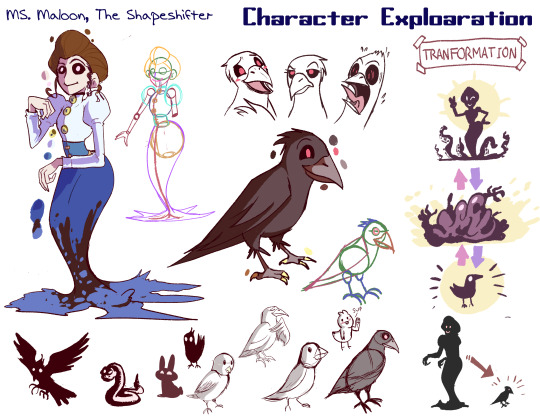
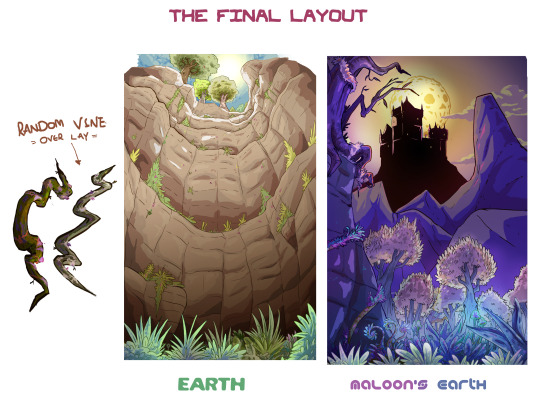

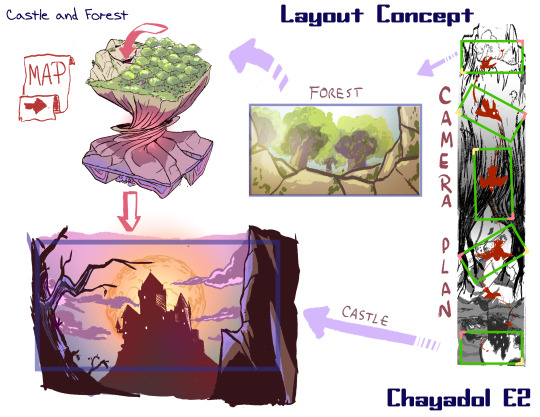
Multiplane Layout assignment that I did for my class
What is Multiplane Layout? some ask...
First of all the word layout is basically setting of that scene what is the audience will see in that particular layout. So layout must have character + background.
and Multiplane is basically a camera panning of the scene. The most important about Multiplane Layout (other than perspective) is how this pan telling story. What is the purpose of the pan and what that story benefit form it.
We barely see the 2D ML nowaday because ML need so much plan and effort to get that panning right and not look off, but it’s pretty cool and look really good.
For me tho, I personally don’t like doing layout, but I love seeing people doing it :D
this semester help me get use to it.. (a little bit lmaooo)
This character is also a part of the original story that I plan to do for later time (still in a very first development stage ;-;)
#layout#multiplane layout#multi-plane layout#concep art#Character Design#props design#crow#shapeshifter
15 notes
·
View notes
Text
making of “dans les bois”
Hey! I've already shown you the trailer of my graduation film, so this time I'd like to give you a little bit of an insight into the process behind it. So here's a tiny making of. I don’t have a lot of pictures, but hopefully you'll find the description itself useful. Let's use The Wolf Scene for visualising the process step by step.
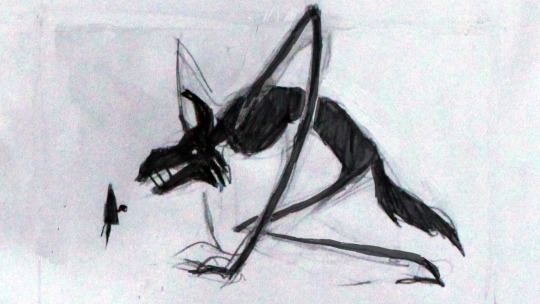
1. Concept
Each scene has to be planned in terms of composition and movement of the characters. The Wolf Scene was the very first shot I imagined, when I started working on this project. I knew that it would be the key scene, so I wanted it to look quite "impressive" haha :) I imagined a huge wolf like creature lurking from behind the trees and walking with big thumping steps through the forest. And so I made the concept:
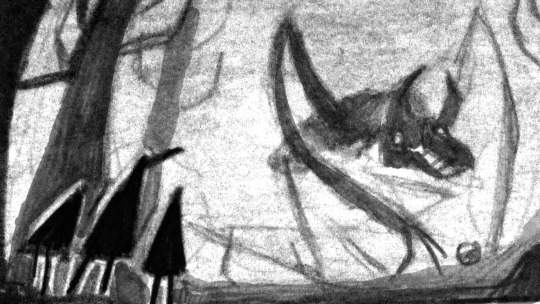
And here’s a beautiful concept of the scene made by Arthur (http://zhaphod.tumblr.com/):
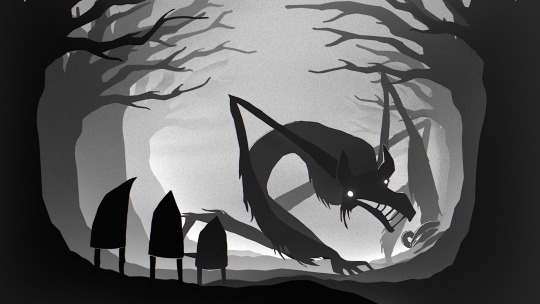
2. Layout
Ok, so we have the concept and now what ? Let's begin with creating a layout. To be honest I didn't have any idea of how to do it ! Really. I had some graphic references, like "Limbo" game, the shadow theatre and the beautiful shadow boxes (thank you Nunu for the great idea ! ). And that's all. I had to test a lot of things and figure out which way would suit me best. I knew that making a bunch of real shadow boxes for all the scenes would be simply impossible (since I only had like 5 - 4 months to complete my film), so I tried fixing the layout together on a little multiplane we had at the school. Unfortunately it didn't look as well as I had hoped it would. Finally someone suggested using After Effects and compositing layers cut out of paper and simulating the multiplane-like look. The outcome turned out to be just what I've been looking for!
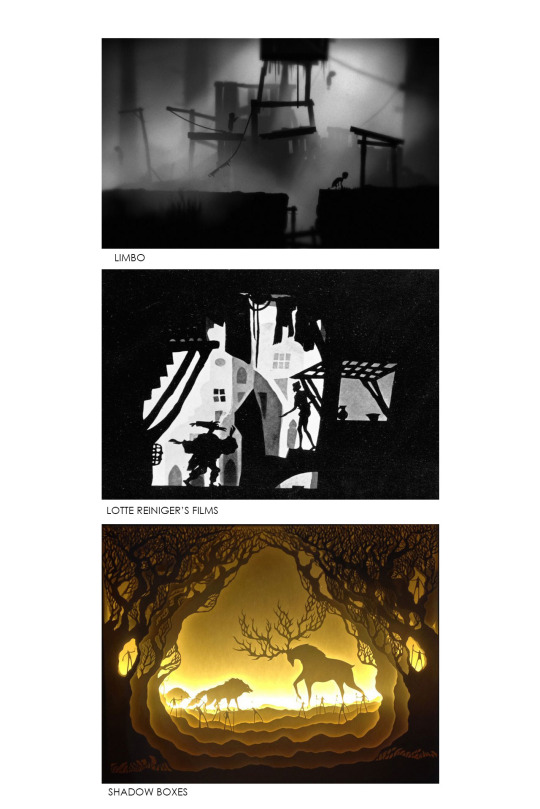
some of my references
3. Paper work
Once I found my way of creating backgrounds I had to have all of the layers cut out of paper. By taking a picture of each layer on a light table I created myself quite a "forest library", from which I could later composit my dream backgrounds. But to be honest, I'm not really good at cutting things out of paper, so I desperately needed help. Thankfully at my school there was a week, specifically designed just for that purpose, where the first year students are helping their older colleagues (I mean us lol) with their grad films. I was lucky to collaborate with Beatrice, who loves doing scenography. And she is precise like a surgeon! After the week she decided to work with me until the end of the production. So she is the one responsible for all the beautiful forest layers full of painstaking details ! And so yes - look at the film scenes, it's a handmade work (except one or two layers I had to cut on photoshop due to lack of time)!
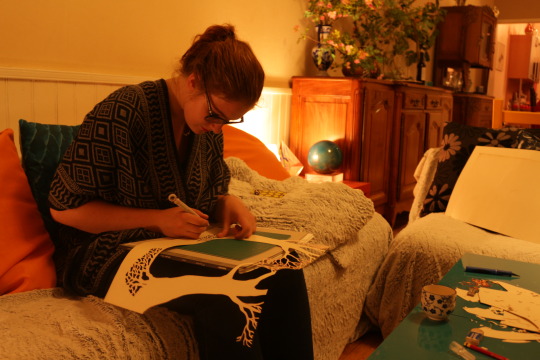
4. Multiplane camera
As soon as I had a new layer done I went to a stop motion studio called "Dynamotion" where I could work on a super pro multiplane! The purpose of taking pictures under the multiplane camera was to capture the beautiful light effect.

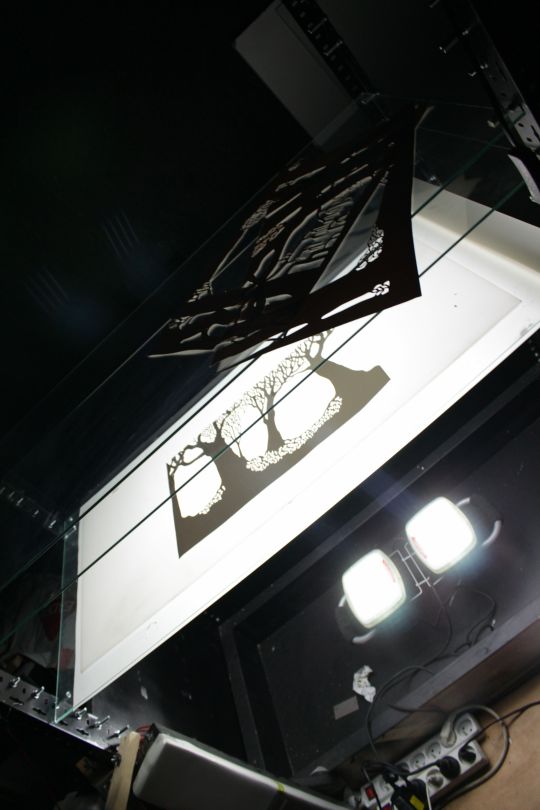
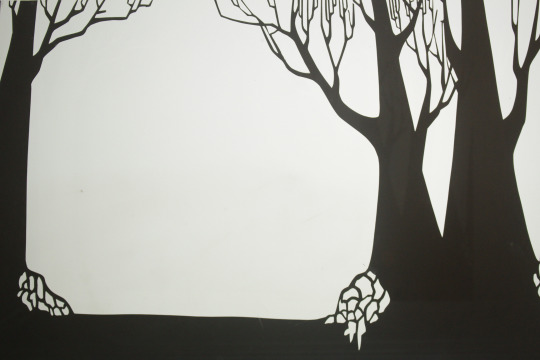
5. Animation
Animation time ! As in the case of my layout I wasn't sure how can I do it. At the beginning I thought I could make a cut out animation, but when I started animating this way I realized it wouldn't be possible to finish the film in time. Finally I decided to animate it on Tvpaint, but I wasn't quite sure if it would work. It was a really hopeless period for me ! Just take a look at the wolf without all the effects !

6. Hello, After effects
The pictures are taken, the animation is finished, so I can composite them together in After Effects. It is also time for adding more light effects, colour grading and so on. At the beginning of postproduction I thought I'm good at After Effects. Then I learnt that I know NOTHING about it. I had to test everything and follow advices of my classmates to find a way of making the scenes look as I wanted.
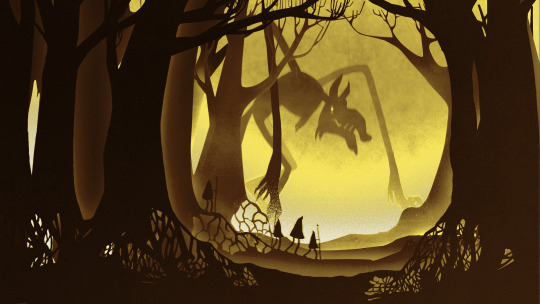
So here you are, a little (horror) story of my film. It was a challenge to make it but it's done! So now I can forget about it and start watching a new season of Stranger Thing
The vimeo premier of my film is on 31st october ! 🎃
63 notes
·
View notes
Text
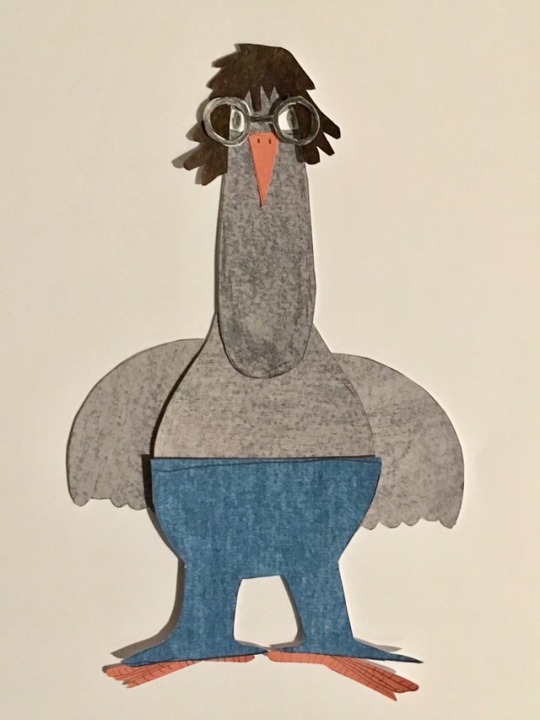

here are my pigeon puppets:
I have finished all of the backgrounds and puppets for the animation so I am ready to film. I have used pencil and shading for all the backgrounds with the pigeon being in more colour to make him stand out. I thought about having the pigeon be pencil as well but when I screen tested it it blended in too much and I think the jeans would be less obvious if they were drawn in pencil. I found that the textured backgrounds for the body that I had worked out before worked extremely successfully.
filming :
I have found effective lighting for my multiplane set up and worked out what setting works best. I’ve also ordered an anti reflective lens so that the reflection in the glass is minimised and also a bitten I can press to take a picture further away from the camera so you can’t see my hand in the reflection. I filmed the intro to the film and it worked very successfully I think. I used clay to make the title for the film, a nod to the claymation animations I love (Aardman, who had a series called creature comforts that inspired my anthropomorphic character but also the shape of the pigeon was very inspired by the penguin from ‘The Wrong Trousers’). The issues I came across with filming were lighting and way that I was going to capture the images but I managed to overcome these setbacks and make a set up that worked reasonably successfully. To improve my approach I would give myself more time to prepare for animating so that I would have to rush as much.
0 notes
Text
PROJECT// PERSUASIONS- SHADOW & PAPER CUT OUT ANIMATION INSPIRATION
Shadow Puppetry is an ancient form of story-telling and entertainment. In a traditional sense, flat articulated puppets are held between a source of light and a translucent screen. More than 20 countries are known to have shadow show troupes. Shadow play is an old tradition and it has a long history in Southeast Asia.
Cutout animation is a form of stop motion, using flat characters, props and backgrounds cut from materials such as paper and card. The worlds earlierst known animated feature films were cutout animations, and the effect remains popular today, with modern films replicating the style with computer scanned images and vector graphics taking the place of the paper.
My groups decision to use cut-out animation in conjunction with shadow/silhouette puppets for the following reasons:
making all of the characters and sets with cut out flat paper instead of 3D materials is a lot faster, giving us more time to actually animate, as well as giving us the opportunity to make a larger number of different sets/locations
using cut paper stop motion under a rostrum camera will allow us to avoid issues like changing lighting/ environment conditions that would effect the shots.
Cut paper animation gives a consistent, cohesive style to all of our characters and sets, meaning everyone in the group could contribute without the film become mismatched.
I had also made a short film during college using paper cut outs and placing them onto an overhead projector and photographing the projections as frames. I have since lost that file, but have screenshots from it, giving an idea what it looked like:

With this past animation in my head, I was also inspired by artists/filmmakers that also inspired me to make that first one:
Lottie Reiniger
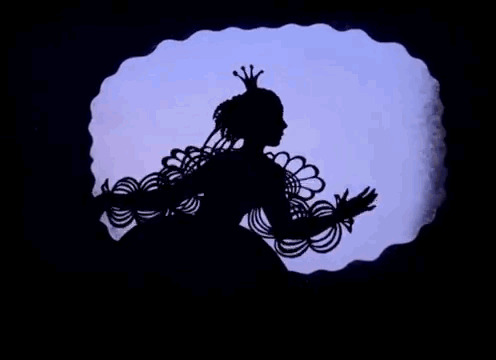
Born in 1899, Lottie Reiniger was a pioneer in the world of animation. She made films telling the stories of classic fairy tales, animated by hand with intricately detailed and articulated paper cut out puppets, placed on a lightbox and photographed frame by frame from above. Her film, The Adventures of Prince Achmed, is the oldest surviving animated feature film. Reiniger is also credited for having invested what was to become the first multiplane camera (the kind used on all of the original Disney films, as well as many modern stop motion and traditionally animated features) she made more than 40 films, all using her invention.
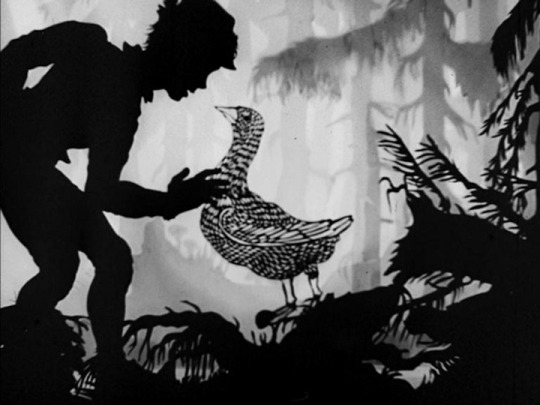
I have been inspired by Reiniger’s work for a long time due to the apparent accessibility of the process, viewing it as a wanna-be animator. I love the simplicity of the silhouettes, which allow the animator to put the majority of their energy into creating convincing movement. The multiplane camera also allows for the illusion of depth with beautiful faded backgrounds. Reiniger’s work was at the forefront of my mind while I was talking to my group about the style we wanted to animate in. The final designs of the characters are a direct result of Reiniger inspiring me.
Arai Wagorō
Ochōfujin no genos (Madame Butterfly’s Illusion) is a Japanese animated short film from 1940. Arai Wagorō was a dentist, and created nearly a dozen short films in the same style between 1939 and 1947.

I found Wagorō’s work through researching Reiniger’s films. Wagorō’s work is very similar in style, except it draws more directly on Japan and Asia’s rich history of shadow puppetry. Like Reiniger’s films I drew a huge amount of inspiration from the design and presentation of the silhouette style, as well as the depth effect of the background.

Harry Everett Smith
The screenshots below are from Smith’s film Heaven and Earth Magic. The film is an American avant garde feature film released in 1957.Instead of silhouettes, Smith animated using Victorian photograph cut-outs. I am very inspired by the innovation in this film- the animation, sound design and comedy are amazing for its time. this piece inspired many other animators, including Terry Gilliam.
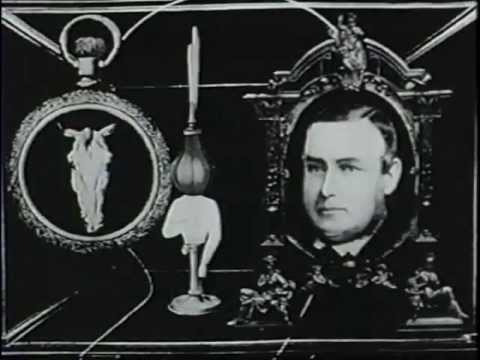
Using 19th century photographs allowed for the creation of some very striking imagery.
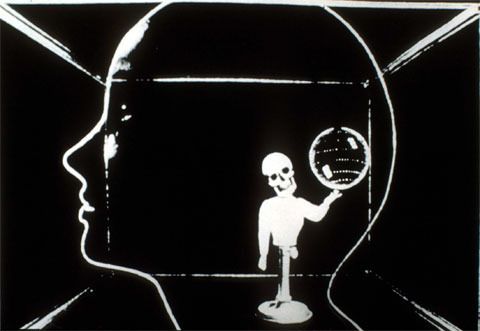
Terry Gilliam
Terry Gilliam was a member of the Monty Python comedy troupe- providing animation, acting, comedy and screenwriting. He joined the group first as an animator- linking the comedy sketches together in the TV show and defining the groups visual language. His animations mix his own art, characterised by soft gradients and odd, bulbous shapes, with backgrounds and moving cutouts from antique photographs, mostly from the Victorian era (as inspired by Harry Everette Smith).
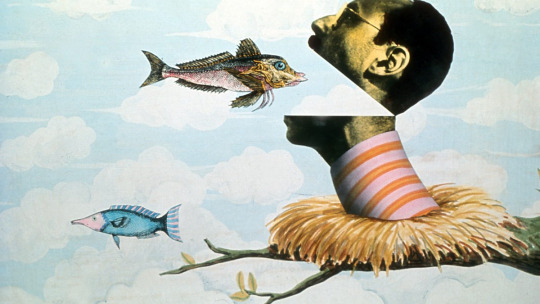
Gilliam’s animation is intentionally rough around the edges, never letting you forget that the images on-screen are, in fact, pieces of cut paper and photographs. The characters move in surreal, jerky ways, and yet still manage to appear dynamic and interesting, mostly due to clever sound design.
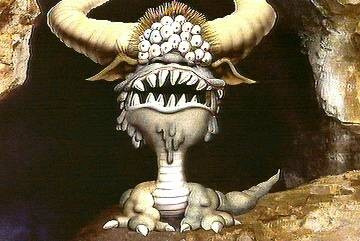
I have been a fan of Gilliam’s work ever since I saw my first Monty Python sketch at a very young age. Like Reiniger’s work, I was drawn to it because I saw a certain level of accessibility for my own efforts. There were things I could learn here. Gilliam’s lack of perfectionism really inspired me in relation to this project, and helped me to understand how exactly my group could animate what we wanted in such a short space of time.
0 notes
Text
brinnanza replied to your post
what's the first?
The establishing shot of Beast’s castle that was made using the multiplane camera, which BLEW MY MIND in 1991 and it turns out was, much like hand painted watercolor backgrounds, super oldschool technique. not the stained glass thing, which i also love but never blew my mind, but the part where you’re in the forest and the trees part and yet somehow also remain still and suddenly the castle is there? and the waterfall and it just feels so incredibly hyperreal.
deets: https://www.youtube.com/watch?v=YdHTlUGN1zw
1 note
·
View note
Video
youtube
The Mechanical Monsters
November 28, 1941. Directed by Dave Fleischer. Produced by Max Fleischer. Voices by Bud Collyer, Joan Alexander, and Jackson Beck. Animation by Steve Muffati and George Germanetti. Story by Isidore Sparber and Seymore Kneitel. Musical arrangement by Sammy Timberg.
General Notes
At first glance you’d think all these cartoons have the same intro sequence, but they don’t. This film features the first onscreen appearance of Superman’s X-Ray vision, which is called out in the intro.
Something I’d urge you to do as you watch these films is to try to avoid looking at them as quaint, old cartoons and see how exciting and dynamic they are, even 75+ years later. How cool do those mechanical monsters look! I love their menacing march at 4:00 and the way the police bullets are drawn bouncing off them. In general the art deco vibe of that whole sequence is just incredible. Modern movies set a high standard for onscreen action and motion, but I think there’s a lot to find captivating here.
The first filmed occurrence of Clark changing in a phone booth comes at 5:00. Shortly after, note that Superman very clearly leaps instead of flying. (This was also true in “Superman”) Later, he falls off the mechanical monster in mid-air, which wouldn’t happen if he could fly. Superman is generally less powerful than he’s become in the comics over the decades. Modern Superman wouldn’t even be slowed down by hitting electrical cables, but here we get a cool sequence where he looks legitimately powerful as he breaks out of the tangled, live wires. Having a Superman who doesn’t seem invulnerable helps create some jeopardy for the characters, too. The Fleischers reportedly didn’t think the leaping looked dramatic enough and asked the publisher if Superman could be given flight. They agreed and we’ll see that in a month or so. (I do think his fast jumps at the end look neat.)
He’s not credited, but Bud Collyer, who had been doing Clark Kent/Superman on The Adventures of Superman radio drama, plays the role in all of the Flesicher & Famous shorts. From The Superman Site’s page on Collyer:
“I played Clark Kent just a little bit higher to give my self somewhere to go with the ‘UP, UP AND AWAY!’” Collyer portrayed Clark Kent as a tenor; dropping an octave in mid-sentence into Superman’s deep baritone as he proclaimed: “This looks like a job - FOR SUPERMAN.” Bud Collyer’s portrayal of the Man of Steel remained the definitive interpretation throughout the 1940s.
The phone booth change in “Mechanical Monsters” is a perfect example of this vocal shift. Kevin Conroy cites Collyer’s approach as inspiration for his portrayal of Bruce Wayne/Batman on Batman: The Animated Series. Christopher Reeve does the same thing physically in Superman: The Motion Picture, slouching as Clark and puffing up his chest as Superman.
7:00 has a wonderful multiplane camera shot of the villain’s lair. Invented by Walt Disney Studios while making Snow White and the Seven Dwarfs, the multiplane camera allowed animators to draw several layers of images — in our case the lair in the background and the rock formations in the foreground — and then place them on top of one-another in the camera, allowing them to move the layers at different rates. It created a sense of realistic depth that hadn’t been possible in animation before. (Aside: Snow White’s friends are “dwarfs”. Tolkein coined “dwarves” at around the same time Disney was making his movie. I prefer Tolkein’s plural generally.)
This story has a sequel by Brian Fies, The Last Mechanical Monster. You can read the Eisner-nominated comic in its entirety here. This sort of story is a great argument for why art should pass into the public domain. Fies had an idea for a sequel and was able to draw it and publish it on his own website and now you can enjoy it.
Mild-Mannered Edition Notes
I didn’t have to do a ton of work on this one. The Warner Home Video version is generally complete, with a few exceptions.
At 1:30ish, after the introduction, there are supposed to be a few seconds of black while the sound of the mechanical monsters breaking out of the National Bank plays. The Warner Home Video version cuts some of this audio and fades in too quickly. I’ve restored the proper timing.
In “Superman,” the Warners’ audio had an odd drop-out during its final moments before a fanfare played over the Paramount Pictures logo. In “The Mechanical Monsters,” the Warner version stops playing the original score entirely and switches to fanfare. I can’t find any other edition of this short that does that — the Paramount fanfare isn’t supposed to be there. Here’s a comparison:
youtube
This issue recurs in many of the videos. I’ll point it out each time but probably won’t keep including it in the making-of features.
📽 YouTube link
↺ Reply ↻ Retweet ♡ Like
5 notes
·
View notes